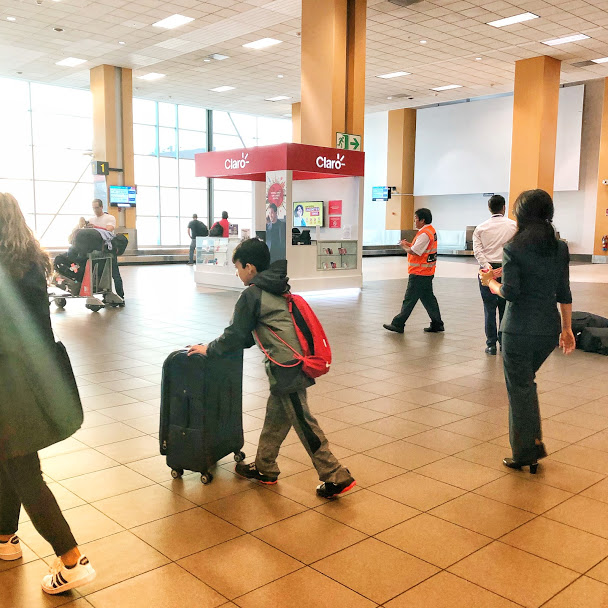Last Updated on August 15, 2019 by travelingwithsunscreen
We almost always go abroad with our handy-dandy travel phones, so one of our very first tasks upon landing in a new country is to get a local SIM card. Buying a SIM card on-site is generally wayyyyyyy cheaper than pre-purchasing one from abroad, and it’s usually pretty easy! Here’s how we got our SIM cards in Lima, Peru, and how much it cost us!
Avoid the airport Claro kiosk
In the baggage claim area in the Lima airport is a Claro kiosk. Since we knew Claro (along with Movistar) to be one of the biggest cell carriers in Colombia, we bopped right on up to the kiosk to get our SIM cards. Wow, couldn’t be easier!
Except. The sign on the kiosk indicated that a seven-day play cost $59 US dollars. But surely that couldn’t be right? Or maybe there would be other plans available?
Nope, and nope. When we asked the woman working there about prices, she told us that a 10-day SIM card, which we were looking to buy, would cost us $70-something, and the cost was indeed in USD. There was only one plan available at this kiosk, and it was an “unlimited” plan, which included the ability to make international phone calls to the US. Has no one heard of FaceTime? Skype? Anyway, this was definitely, 100% not what we were looking for. All we really needed was some data!
NEVER pay anything close to $70 USD for an international SIM card. We know how to travel on a budget, and we promise, they’re actually really cheap. You can get a SIM card in Lima for about a fifth of that price.

Holidays make it difficult to find SIM cards
The day we arrived in Lima was Good Friday. Peru is a very Catholic country, and both Holy Thursday and Good Friday are taken quiet seriously. (For example, our Airbnb host, like many other Lima residents, had left the city to visit relatives in the countryside for the long weekend). While many local restaurants catering to tourists remained open, many national chain businesses, like Starbucks(!), were closed.
This included, apparently, the cell phone carriers. There was a Claro store near us in the Miraflores neighborhood, where we were sure they would have other, less outrageous, plans available. Closed. Another carrier, Entel, also had a store, but this was also closed. We even stopped in a random electronics store, but they told us that they didn’t carry SIM cards at all.
Movistar had a store near us as well, in a mall, but the mall wouldn’t be opening for another couple of hours. It was our last hope, but we had very little confidence that it would be open.
Luckily, Ethan has T-Mobile on his regular cell phone, which comes with free (slow) international data. Definitely enough to tide us over, but it looked like we wouldn’t be getting new SIM cards anytime soon.
UPDATE: Most of these businesses were open again on Saturday, although many of them were closed again on Easter. So take it day by day!
The day is saved! Most convenient SIM-card store in Lima!
So by now we had given up on this endeavor, and we were off to the supermarket to stock up on giant bottles of water for our apartment. And what did we spy right next to the supermarket, but a cell phone store with signs, in English, advertising “Tourist SIM Cards.” And it was OPEN!!
Yes, it was just a small, very local, not-so-professional looking cell phone store, called La Casita del Celular. But they turned out to be so helpful, and they had exactly what we needed.
This store sold SIM cards by Bitel, Peru’s fourth-largest carrier. The SIM cards cost 20 soles to activate (about $6 USD), and they had a variety of plans available depending on the length of time needed. They laid the plans out for us clearly and in writing (no need to understand rapid-fire Spanish here at La Casita del Celular!), and we chose a ten-day plan with 3 gigabytes of data for another 20 soles (again, $6 USD). SUCH a game-changer compared to the total scam that was the Claro airport kiosk. And, although Bitel is not the largest carrier in Peru, we had service everywhere we went in Lima, Cusco, and Aguas Calientes. (We didn’t have service at Machu Picchu, though.)
Our recommendations
Assuming it’s not a national holiday, your best bet is probably to go to one of the actual carriers’ stores in Lima to get a cheap data plan suited to the length of your stay. You may need to bring a passport as documentation to get this, so be prepared! But, if they’re not open, don’t despair! Stop by the Casita del Celular, and they’ve got you covered for your SIM card in Lima.
Have any advice about SIM cards abroad? We’d love to hear it!
Like this Post? You might also be interested in these!
Lima, Peru Daily Budget
Why We Have Travel Phones and You Should Too!
How to Get Cell Data Abroad
What to Bring to Machu Picchu (and what to leave behind)

